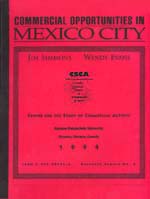 Commercial Opportunities in Mexico City
Commercial Opportunities in Mexico City
by J. Simmons and W. Evans, Centre for the Study of Commercial Activity, Ryerson Polytechnic University, 1994Report Introduction:
The visitor to Mexico City is overwhelmed by the diversity of the urban landscape. The city is at once New World, Old World and Third World, with rich and poor, urban and rural, modern and traditional, colonial and indigenous, all scrambled together; above all, the range of lifestyles is extended into degrees of poverty that are unfamiliar for people from the developed world. The result is unpredictable: some vistas are colorful, stimulating, delightful, others appalling and profoundly depressing. Some institutions work marvelously; others, disastrously.
Nowhere is this complexity more evident than in the commercial landscape. It covers an extraordinary range of forms and activities - from open markets and street vendors, to streets filled with identical stores selling the same goods, to 21st century shopping malls - and all the variants in between. Even the poorest areas are alive with stores and vendors. This paper will summarize the significant aspects of this commercial structure, taking the viewpoint of the modern retail chain, seeking new locations: how large is the market and where is it located? What locations give the best access to the market? What is the competitive structure, in the sense of competing locations and activities? This study was initiated as part of an SSHRC grant to compare commercial structures in major cities around the world, and for this reason the Mexico City results will be compared to a parallel study of Toronto wherever possible. These comparisons also determine the organization of the paper, which involves in turn, a description of the market, an overview of the commercial structure, a discussion of the competitive environment, and an evaluation of the regulatory system.
In terms of population Mexico City is one of the largest cities of the world, with a metropolitan population of over 15 million; but in terms of income or considered as a retail market it is relatively much smaller. The $15.5 billion total income in 1990 is the size of a medium-sized North American city, perhaps Buffalo or Vancouver, and about one-quarter of the Toronto market. This paradox in which many people generate little income will emerge again and again in the discussion below, as the size of the market is analyzed, and then its growth, spatial distribution, and patterns of consumption. From the viewpoint of the Canadian retailer, the notion of the average household in Mexico City is irrelevant: who can sell goods to a household with an income of only $5000 US per year? Instead the market must be disaggregated by income, in order to focus on the subset of households that can afford to shop in conventional stores. How many of these households are there? Where are they located? And what do they buy? The result of this disaggregation and the focus on higher income groups is a market that is even smaller, but appears to be more familiar. In size, in spatial distribution, and in consumption patterns, this part of the Mexico City market resembles a small North American city.
